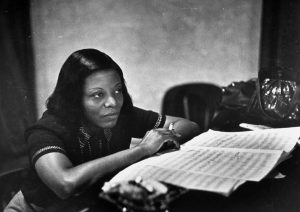I’ve been looking for an appropriate time to talk about Mary Lou Williams in a blog post all semester. Admittedly, this blog post does not have much connection to class, but I find her music so quintessentially American; in listening to her catalogue chronologically, one can distinctly hear the progression of jazz itself. Along with Duke Ellington, she is one of very few stride pianists to make the transition into swing. More importantly, throughout her career, she maintained a strong commitment to care and activism within the jazz community.
During Franklin Roosevelt’s second run for presidency, Mary Lou felt so strongly about FDR’s run that she went on tour with “The People’s Bandwagon.” She wrote “Ballot Box Boogie in the Key of Franklin D,” as a theme song and rallying cry for Roosevelt’s chances. When asked about prospective voters who might be interested in voting for the opposition, Mary Lou said,
“Roosevelt has done as much as any President could do for colored men and women… I had to talk to them to change them… They don’t realize anything, d’you know? I’ve been beating my brains out for Roosevelt for quite a while, talking and talking.” 1
Mary Lou Williams didn’t just work for federal issues either. In the 1940s, Mary Lou Williams left the Andy Kirk and Duke Ellington bands, and minimized her touring schedule. She moved back to her hometown of Pittsburgh, and then to 63 Hamilton Terrace in Harlem. There, she led consistent jam sessions with Dizzy Gillespie, Art Tatum, Charlie Parker, and other bebop giants. Despite being nearly ten years older than these musicians, Williams’ incredibly advanced compositional and improvisational styles fit right into the bebop era. While composing, performing, and holding these salons with other jazz musicians, she also worked within the Harlem community at large. In the article, “Mary Lou Williams Likes Her ‘Jams’ and Fighting Juvenile Delinquency,” the author describes Williams’ commitment to her community.
“Along about evening-time, Mary Lou goes incognito to one of the most dangerous sections of Harlem… and tries to discover why the delinquents and gang leaders are so vicious in their attacks… she walked the streets that night until she found the leader and made friends with him. He took her into his confidence and it wasn’t long before she was being told his problems.” 2
In 1954, Williams took a 3 year hiatus from playing at all, after abruptly stopping a performance in Paris. She began composing more experimental work, including a complete jazz mass. Within this hiatus, she converted to Catholicism and renewed her commitment to her community.
“After experiencing the death of Charlie Parker and witnessing the deterioration of Bud Powell, Williams decided to intervene. In addition to taking musicians to church, she turned her one-bedroom apartment into a one-woman rehabilitation center. 63 Hamilton Terrace became a halfway house where Williams detoxified, fed, clothed and found work for addicted musicians. The worst cases she housed in a room down the hall that she rented cheaply from a neighbor. Musicians usually stayed a couple of weeks and, when possible, left clean, sober and with employment.” 3
Mary Lou Williams not only was an incredible composer, but she also worked incredibly hard within her community to uplift and support her colleagues and peers.
1 Hayakawa.
2 “Mary Lou Williams Likes Her ‘Jams’ and Fighting Juvenile Delinquency.”
3 Kernodle.
BIBILOGRAPHY
Calloway, Earl. 1971. “Mary Lou Williams, a Great Jazz Pianist.” Chicago Daily Defender (Daily Edition) (1960-1973), Jun. 29, 12. https://www.proquest.com/historical-newspapers/mary-lou-williams-great-jazz-pianist/docview/494305149/se-2?accountid=351.
Hayakawa, S. I. 1944. “SECOND THOUGHTS: MARY LOU WILLIAMS, PIANIST.” The Chicago Defender (National Edition) (1921-1967), Nov. 04, 15. https://www.proquest.com/historical-newspapers/second-thoughts/docview/492782453/se-2?accountid=351.
Kernodle, Tammy. 2019. “A Woman’s Place: The Importance Of Mary Lou Williams’ Harlem Apartment.” NPR, Sep 12, 2019. https://www.npr.org/2019/09/12/758070439/a-womans-place-the-importance-of-mary-lou-williams-harlem-apartment
“Mary Lou Williams Likes Her ‘Jams’ and Fighting Juvenile Delinquency.” 1947.The Chicago Defender (National Edition) (1921-1967), Oct. 11, 18. https://www.proquest.com/historical-newspapers/mary-lou-williams-likes-her-jams-fighting/docview/492742095/se-2?accountid=351.
“ON BANDWAGON FOR FDR.” 1944.The Chicago Defender (National Edition) (1921-1967), Oct. 07, 7. https://www.proquest.com/historical-newspapers/on-bandwagon-fdr/docview/492729391/se-2?accountid=351.

